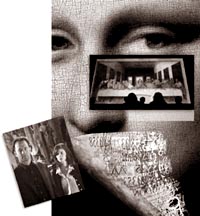|
observer |
|
|
|
|
|
OTHER LINKS |

|

|

|
|
DEBATE: De-coding the Da Vinci Code
Dan Brown even goes to the extent of questioning secular history and the very foundation of western civilization and faith-based religions (Christianity). He perceived "faith" as something based on fabrication. Through his mouth-piece, the Da Vinci Code's main character, Harvard - qualified "symbologist" Robert Langdon. Brown airs his views and beliefs on the concept of faith particularly against Christianity. "Every faith is based on fabrication. That is the definition of faith-acceptance of that which we imagine to be true, that which we cannot prove. Every religion describes God through metaphor, allegory and exaggeration, from the early Egyptians through modern Sunday school. Metaphors are a way to help our mind process the unprocessible. The problems arise when we begin to believe literally in our own metaphors....Those who truly understand their faiths understand the stories are metaphorical" (pages 341 and 342). The Da Vinci Code takes on the Catholic church and its belief about Jesus Christ, the Bible and the church's authority based on seemingly accurate historical facts. However, those "facts" are also fictional and aims at misrepresenting and distorting church and secular history and tries to promote a radical feminist, neo-gnostic agenda. The book also encourages its readers to take an indifferent attitude towards truth and religion. The concept of Mary Magdalene and Sacred FeminineAccording to the novel the Mary Magdalenes being described as the apostle of Jesus and is the Holy Grail. "As Sandra Miesel says in Crisis Magazine of September 2003 in an article titled "Dismantling The Da Vinci Code", Brown's book is more than just the story of a quest for the Grail he wholly reinterprets the Grail legend. In doing so, Brown inverts the insight that a woman's body is symbolically a container and makes a container symbolically a woman's body. And that container has a name every christian will recognise, Brown claims that the Holy Grail was actually Mary Magdalene. She was the vessel that held the blood of Jesus Christ in her womb while bearing his children." According to Brown, the chalice of the Holy Grail is not a cup but a symbol of a "woman's womb", embodying femininity, womanhood and fertility. He states "The Grail is literally the ancient symbol of womanhood, and the Holy Grail represents the sacred feminine and the Goddess, which ofcourse has now been lost, virtually eliminated by the church. The powers of the female and her ability to produce life was once very sacred but it posed a threat to the rise of the predominantly male church, and so the sacred feminine was demonised and called unclean....It was man, not God, who created the concept of "original sin" whereby Eve tasted of the apple and caused the downfall of the human race. Woman, once the sacred giver of life,was now the enemy. Brown also accuses and claims that the church from its very inception "had subjugated women, banished the Goddesses, burned non believers, and forbidden the pagan reverence for the sacred feminine and that the marriage of Jesus and Mary Magdalene is a part of the historical record." He bases this premise on one of his sources, Elaine Pagels controversial book, Gnostic Gospel (1979) and the Gospel of Phillip, which describes Christ kissing Mary Magdalene "on the mouth" offending and upsetting the disciples. Brown also arrives at his main point "Jesus was the original feminist. He intended for the future of His Church to be in the hands of Mary Magdalene. He also announces that Jesus's "supposed marriage to Mary Magdalene is the greatest cover up in the human history." In a critique by Cart E. Olson and Sandra Miesel attributes the concept of Sacred Feminine to recent "neo-Gnostic, feminist works seeking to re-write early church history based upon Gnostic writings such as the Gospel of Thomas, the Gospel of Phillip, the Gospel of Mary and a handful of others. In addition to Pagel's work and Holy Blood, Holy Grail, there are other esoteric histories making similar statements: The Templar Revalation: Secret Guardians of the True Identity of Christ by Lynn Picknett and Clive Prince; Goddess in the Gospels: Reclaiming the Sacred Feminine and The Woman with the Alabaster Jar: Mary Magdalene and the Holy Grail, the latter two both by Margaret Starbird, a former Catholic who has been long associated with Matthew Fox. All of this activity is part of a rapid growing interest in Gnosticism and "alternative" forms of Christianity that are making overt appearances in popular media including novels, television, and movies. An example of the latter was the 1999 anti-Catholic dud, Stigmata, which depicted the Catholic church as furiously attempting to cover up subversive "truths" located in Gnostics works such as Gospel of Thomas. A much more successful effort was the hugely popular Matrix, which melded neo-Gnostic ideas with themes from Buddhism and other Eastern religions. We hope that the audience would consider the "Da Vinci Code" as an absorbing and an exhilarating thriller and would not take some of the controversial views, particularly those on Christianity, as Gospel Truth because they are both dangerous and dubious that are not only contrary to the Catholic doctrine but also contrary to historical evidence, sound scholarly work and even common sense. Following the ban on the film based on the Da Vinci Code, leading public personalities including academicians, writers, artists and theologists have expressed their opinion on the Da Vinci Code and the freedom of Artistic expression. Here are some of the views:
Let the people decideBut really, what this should be all about is not what we think of the book, but why did the government of Sri Lanka feel it had to ban the film. Let the people decide on what sort of entertainment they would like to spend their time and money on. The government, it would seem, have more serious problems on its hand. If any one can have a 'problem' with the book and film, it has to be the Catholic Church. And I suppose they have the moral right to caution their congregation on the possible dangers to their dogma and doctrine the book and film may have on the more gullible. But that is where it has to end. And if I truly feel in some way, a film insults my faith or belief system, I will not go and see it. But do not ban it. That will only make me want to absolutely go see it. And on a cynical note, that marketing tactic is as old as the hills. Dr. Vijaya Corea says:- Sri Lanka has thought it necessary to give state patronage to religion. In the light of Sri Lanka's strong protest against criticism or perceived insults to Buddhism, it is understandable that the President banned the Da Vinci Code. We remember the fiasco that followed Salman Rushdie for many years even with a price on his head. Sri Lanka has sensitively dealt with material derogatory of all her religions. Considering the fact that, in the recent past in Sri Lanka, minority Christians felt threatened, it is refreshing to see the attitude of President Mahinda Rajapakse to heed Christian sensitivities. You would note that Pakistan and neighbouring Tamil Nadu did the same. However, Christianity is an anvil which has worn out many an intellectual hammer which came against it. French Philosopher Voltaire expected Christianity to be extinct in 50 years but his own residence was turned into a Bible printing press within 50 years of his death. Christianity does not need state patronage for its survival. All who value intellectual integrity should realise that Da Vinci Code is not fact but fiction sewn together with some historical figures thrown into the story line. Its fallacy has been well exposed. Factual errors regarding Dead Sea scrolls abound in Da Vinci Code which makes it not a scholarly work but a novel. Verifiable historical errors too abound in the Da Vinci Code. Intelligent people will check out the deductions of the Da Vinci Code from original sources. Professor Ranjini Obesekara is of the view that the Da Vinci Code is a second rate fictional mystery novel and that she does not think worthy of the attention it has received. Ashok Ferrey, the writer of Colpetty People has strong views on the banning of the one faculty that separates us grown up men, from dogs is our ability to distinguish and choose: between right and wrong, good and evil, fact and fantasy. By banning films like this the authorities run the risk of sending us this message: that only they can choose, they know best; we the public are no better than dogs. This kind of censorship has a sort of self-fulfilment about it. If the choices available to us are only "good" ones, over a period of time our critical faculties will be blunted, our perceptions dulled, and we will end up no better than dogs. Is this really what they want? So I would tell the authorities, "Please: don't underestimate us. We are not as stupid as you think. We're not even as stupid as we look!".
So, I decided to take it as an invention and this peters out at the end because after building up the mystery and creating a lot of suspense, there are several points that we should look at how the whole thing going to go up in smoke meanwhile some intervention is going to take place which will wipe it all out and then at the end, when it actually try to give two young people as the blood line of Jesus that it was the whole idea is. There weren't any identified decendents and the book, till the end, remains a mystery. As a plot I feel that it tends to end become an anticlimax because it being built up for expect a major surprise as the solution and the final, information and the two young people are identified as the blood-decendents of Jesus. It tracks backs backs to the idea of Jesus was actually married to Mary Magdalene. That part of if derived from it. There is no evidence except that in the painting of last supper, it is claimed that the figure on the right of Jesus held to be the youngest disciple and a very attractive youth is actually a woman and that was the wife of Jesus. Again the deduction comes entirely from the myth and it may be equally be accounted for as a face of a very attractive man. The figure is not in any sense seen as in a special relationship with Christ at that point. What keeps the novel going is that takes you through a various secret rights and rituals, underground places, etc.... I cannot think of it being anything that Christians need to take seriously because except for the idea of such an invention being attempted reveals the work of a purely secular mind and intrinsically irreligious mind because something very sacred is taken and played around with, for the sake of sensation. It is difficult to come to the conclusion that he really wanted to attack Christianity but it looks like that because he is willing to play with something sacred to millions of people without really solid evidence. It is not an important novel an attempt that someone wanted for pour dirt on something sacred for the sake of millions which could made out of it, is highly offensive. I do not believe in banning at all because it encourages more publicity, therefore, it should be ignored.
Dan Brown followed it and created his book. So, both are acts of creation of the imagination and we as artists and writers have the power and the beauty to create our own message, just like Ashoka Handagama when he said Queen Maya died after Siddhartha was born, I do not know how far that is correctly recorded. That again I believe that it is his imagination because it fitted in his work and as an exploration. So, when creative people do creative work, it is wrong for higher authorities to assume that they are speaking the truth because that is merely creations of their own. If people are going to believe what is shown on the movies or in books I do not think that is the purpose of Artists or creative writers. I firmly believe, though it is on a sensitive subject, that it should be shown because it is not the correct version of the religion. Those who believe in the religion should be able to look at this as creation of an artist. Ms. Sita Kulatunga, the renowned author, translator and former editor of the open university: when any book of fiction comes out, particularly, now we find even any book written in the first person the first thing that the people ask is this what happened to you. That is the general attitude of the audience. So like that the Da Vinci Code also, it is basically we have to accept that it is a book of fiction written with a lot of meticulous research regarding certain aspects of it. Therefore it is I suppose it is convincing up to a certain point but by no means it is a great classic. It is just a book of or ordinary fiction. At times there are occasions when certain things boarder on science fiction in the middle of the story. So, I think it is not quite right to take it all this seriously. I am sure that this kind of publicity contributes to putting the sales up everywhere in the world.... I don't think that it really needs this kind of critical attention. Where the film is concerned though we have not seen it, I feel that it is just another film based on a novel and it should have been shown and let the people to make up their own minds about it. I really do not think that we should take all the characters and the sub plots in it seriously. Of course I enjoyed reading it up to a point but certain parts of it I found a little boring. It is worth reading, I suppose, to while away the time. I maintain that it is not a great work of art. I believe that the audience should have been left to find out what the film is like. Banning it really make people more curious about it. Even the construction of the book, I don't find it wonderful. At times there is repetitive quality in the construction.
Screening the film will hurt several religious sentiments and disturb the smooth functioning of the social order. If the character is of an unknown person it is suitable for screening but not of a religious leader. A writer should not meddle with a character of a religious leader. |
 A thriller, the Da Vinci Code which casts serious doubt on the
historical concept of God; Catholic Church, Christian Theology Mary
Magdalene, the Council of Nicaea, the New Testament canon, the church
Architecture and witch-hunt during medieval times, tries to reinforce
"sacred feminine" and a re-vitalised worship of Goddess or Goddesses.
A thriller, the Da Vinci Code which casts serious doubt on the
historical concept of God; Catholic Church, Christian Theology Mary
Magdalene, the Council of Nicaea, the New Testament canon, the church
Architecture and witch-hunt during medieval times, tries to reinforce
"sacred feminine" and a re-vitalised worship of Goddess or Goddesses.
 Maestro Luxman Joseph de Saram, what I think of "The Da Vinci Code"
the book, other than it being a first class thriller, the most lasting
impression and a very significant one at that, was how Dan Brown managed
to almost permanently change the way I view both paintings "The Madonna
of the Rocks" and "The Last Supper". Almost akin to how the great
maestro celibidache was able to illuminate a late Bruckner symphony from
within, shedding light and making 'sense' on the otherwise hydra-headed
enigma.
Maestro Luxman Joseph de Saram, what I think of "The Da Vinci Code"
the book, other than it being a first class thriller, the most lasting
impression and a very significant one at that, was how Dan Brown managed
to almost permanently change the way I view both paintings "The Madonna
of the Rocks" and "The Last Supper". Almost akin to how the great
maestro celibidache was able to illuminate a late Bruckner symphony from
within, shedding light and making 'sense' on the otherwise hydra-headed
enigma.  Professor Ashley Halpe commenting on Da Vinci Code said that it is a
thriller and a mystery novel. At first I tried very hard to take it
seriously because you think there is some real content but you find that
the plot depends on conjecture and is not on any kind of documents,
evidence, or tradition.
Professor Ashley Halpe commenting on Da Vinci Code said that it is a
thriller and a mystery novel. At first I tried very hard to take it
seriously because you think there is some real content but you find that
the plot depends on conjecture and is not on any kind of documents,
evidence, or tradition.  The eminent writer
Punya Kante Wijenaike says that Leonardo Da Vinci
is an artist who created "Last Supper" from his imagination and you
cannot see it as the real picture of the "supper" where Christ had the
last supper.
The eminent writer
Punya Kante Wijenaike says that Leonardo Da Vinci
is an artist who created "Last Supper" from his imagination and you
cannot see it as the real picture of the "supper" where Christ had the
last supper.  Ms. Kusuma Karunaratne Senior Professor of Sinhala
at the University of Colombo firmly believes that the film should not be
shown as it deals with one of the most sensitive issues.
Ms. Kusuma Karunaratne Senior Professor of Sinhala
at the University of Colombo firmly believes that the film should not be
shown as it deals with one of the most sensitive issues.






